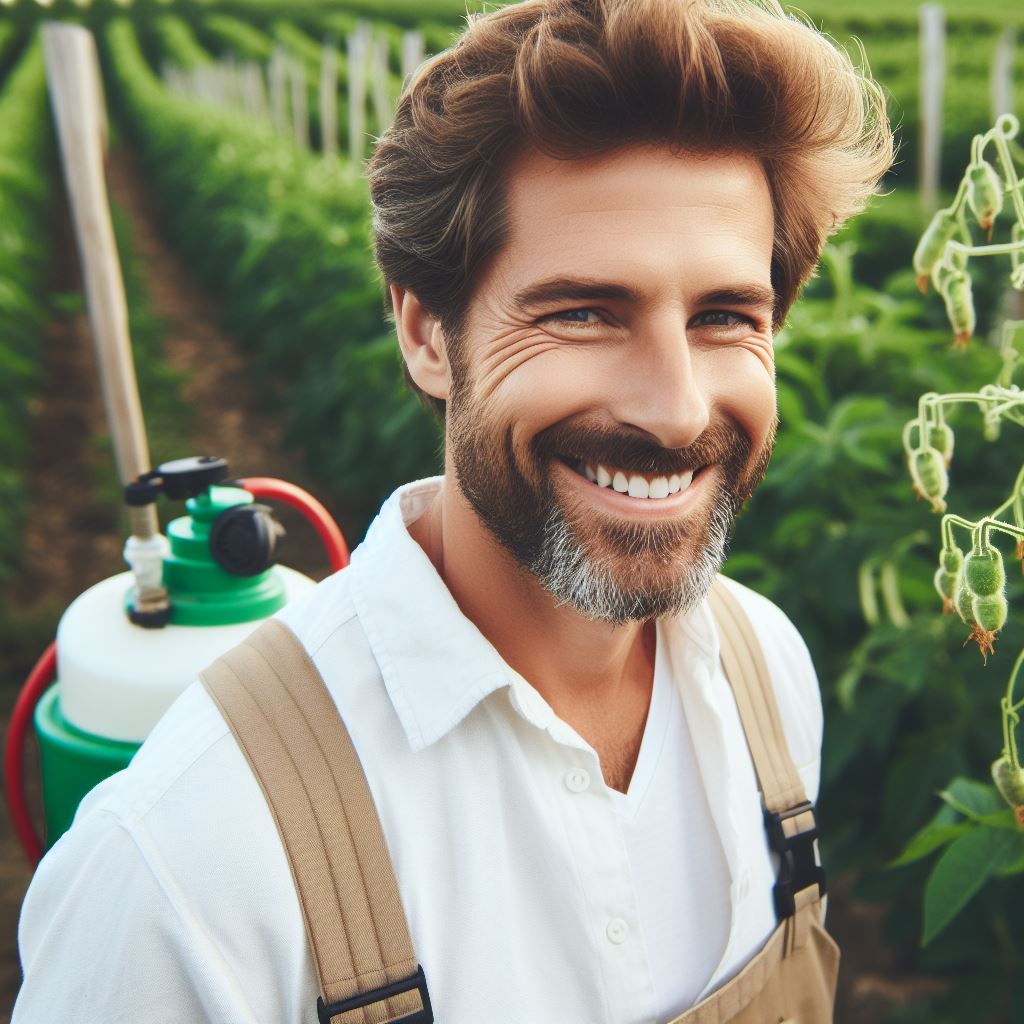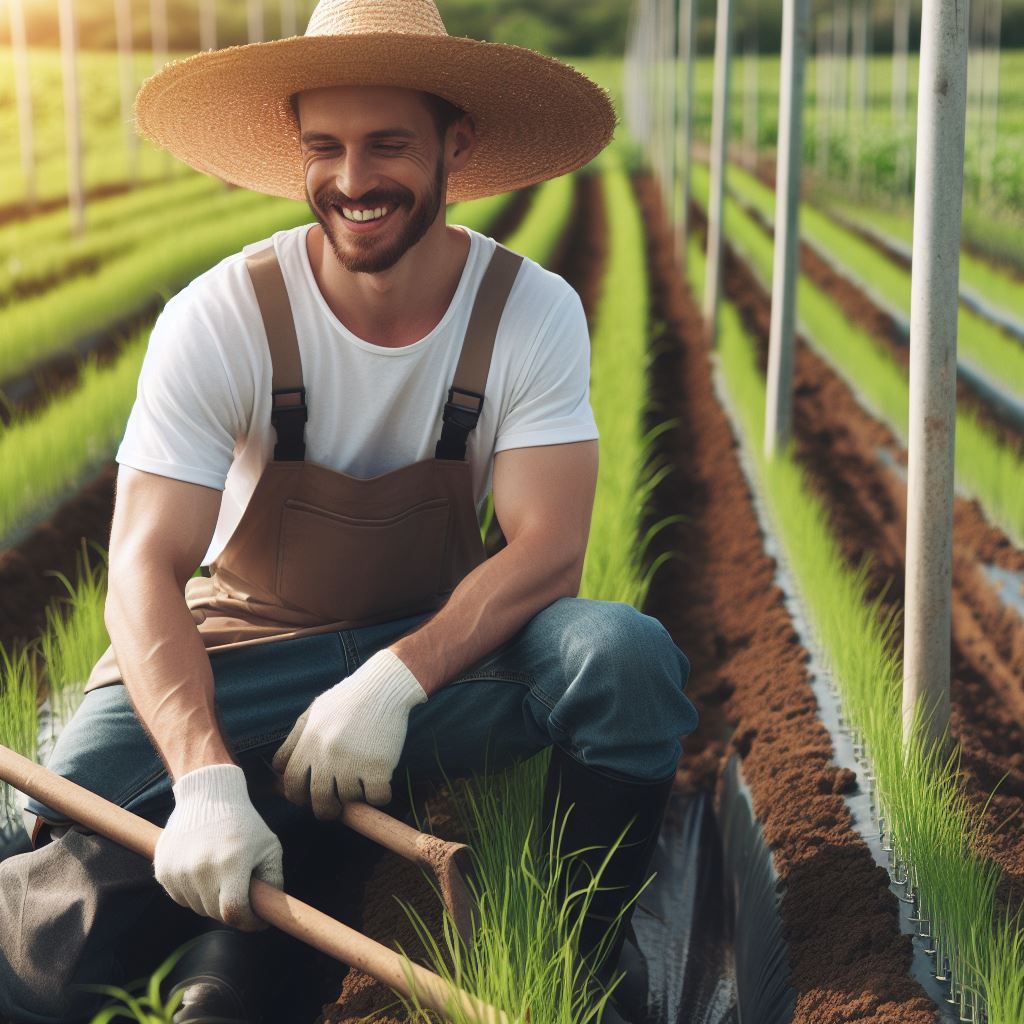Introduction
Pest control plays a crucial role in organic farming, ensuring the health and productivity of crops.
In this blog post, we will explore the importance of pest control in organic farming and provide an overview of the content covered.
Pest control is essential in organic farming to prevent damage caused by pests and diseases. It helps maintain crop quality while adhering to organic principles, which prohibit the use of synthetic pesticides.
Effective pest control strategies are necessary to protect plants and minimize yield losses.
In this blog post, we will delve into various aspects of organic pest control. We will discuss natural pest control methods such as biological control, crop rotation, and physical barriers.
Additionally, we will explore the significance of beneficial insects and how to attract them to the farm.
Furthermore, we will provide insights into the importance of soil health and its connection to pest management in organic farming.
Cover cropping and companion planting techniques will be explored as effective ways to deter pests while enhancing soil fertility.
Additionally, we will highlight the role of advanced technologies, such as pheromone traps and insect monitoring systems, in organic pest control.
Finally, we will discuss the challenges faced in organic pest management and provide tips for successful implementation.
This blog post aims to equip organic farmers with essential knowledge and practical strategies for effective pest control, promoting sustainable and eco-friendly farming practices.
Let’s dive into the world of organic pest control and discover the solutions for a healthier agricultural future.
What is organic pest control?
Definition and principles of organic pest control
- Organic pest control refers to the use of natural products and methods to manage pests without synthetic chemicals.
- The principles of organic pest control include promoting biodiversity, enhancing ecosystem services, and minimizing harm to the environment.
- It focuses on finding a balance where pests are controlled, but beneficial insects are not harmed.
Key factors distinguishing organic pest control from conventional methods
- Organic pest control avoids the use of synthetic pesticides, which can have harmful effects on human health and the environment.
- Instead, it relies on cultural, biological, and mechanical methods to control pests.
- These methods include crop rotation, companion planting, natural predators, and physical barriers.
Emphasis on prevention and sustainability
Organic pest control places a strong emphasis on prevention rather than relying solely on pest eradication.
- By creating a healthy and balanced ecosystem, pests are less likely to become a problem.
- Preventive measures include maintaining healthy soil, using resistant varieties, and practicing good sanitation.
- This approach promotes long-term sustainability by reducing the dependence on chemical pesticides and preserving biodiversity.
Organic pest control is an effective and environmentally friendly approach to managing pests.
By implementing preventive measures and utilizing natural methods, it aims to maintain a balanced ecosystem while minimizing harm to humans and the environment.
Transform Your Agribusiness
Unlock your farm's potential with expert advice tailored to your needs. Get actionable steps that drive real results.
Get StartedThrough its emphasis on sustainability, organic pest control offers a long-term solution that supports biodiversity and promotes a healthier planet.
Read: Eco-Friendly Pest Control in Modern Farming
Common Organic Pest Control Methods
Cultural practices
Effective organic pest control involves a combination of these methods to maintain healthy and pest-free plants.
Cultivating a diverse garden ecosystem is essential since it promotes natural pest control mechanisms. By practicing cultural methods, such as crop rotation, farmers can disrupt the pest life cycle.
This technique prevents pests from becoming established and reduces the need for chemical treatments.
Companion planting is another effective cultural method. By strategically growing certain plants together, they benefit from natural pest repellents or attract beneficial insects.
For example, marigolds deter nematodes, while parsley attracts hoverflies, which eat aphids.
Sanitation and weed management plays a crucial role in organic pest control. Removing decaying plants and weeds eliminates breeding grounds for pests.
It also reduces the likelihood of diseases spreading, significantly decreasing the risk of pest infestations.
Biological control
Biological control methods involve harnessing nature’s defense mechanisms. Introducing beneficial insects, such as ladybugs or praying mantises, can help control pests like aphids or caterpillars.
These predators feed on the pests, keeping their population in check.
Attracting natural predators to the garden is another effective biological control strategy. Creating habitats like birdhouses and planting native flowers can attract birds and beneficial insects.
These natural predators will help control pest populations by feeding on them.
Using microbial agents for pest control is a safe and sustainable approach. Naturally occurring bacteria or fungi, such as Bacillus thuringiensis or Beauveria bassiana, can inhibit pest growth and reproduction.
These microbial agents specifically target pests while being harmless to beneficial insects, wildlife, and humans.
Physical barriers and traps
Physical barriers and traps provide another layer of protection against pests.
- Row covers and netting are used to physically block pests from reaching plants.
- These barriers are especially useful for protecting crops from pests like beetles or cabbage worms.
- Sticky traps and pheromone traps are effective tools for monitoring and controlling pests.
- Sticky traps catch flying insects, such as whiteflies or fruit flies, by trapping them on adhesive surfaces.
- Pheromone traps use synthetic hormones to attract male pests, disrupting their reproductive cycle.
In fact, organic pest control methods offer sustainable and environmentally friendly solutions.
By implementing cultural practices, biological control, and physical barriers, farmers and gardeners can effectively manage pests without resorting to harmful chemicals.
These methods promote biodiversity, protect beneficial insects, and ensure a healthy ecosystem for plants to thrive.
Read: Resilient Crops: Adapting to New Climates
Organic pesticides: Understanding the options
Overview of approved organic pesticides
Organic pesticides refer to the substances used for controlling pests in an environmentally-friendly way.
These pesticides are derived from natural sources, making them safe for humans, animals, and the environment.
- Neem oil: Extracted from the seeds of the neem tree, it targets a wide range of pests.
- Pyrethrin: Derived from chrysanthemum flowers, it is effective against various insects.
- Bacillus thuringiensis (Bt): A bacteria-based pesticide that specifically targets certain insect larvae.
- Diatomaceous earth: Consisting of fossilized algae, it controls pests by dehydrating them.
Natural ingredients commonly used in organic pesticides
Organic pesticides utilize natural ingredients that have proven effective in combating pests. These ingredients are readily available and less harmful compared to synthetic alternatives.
- Garlic: Known for its repelling properties, it is effective against insects like aphids and mosquitoes.
- Citrus oil: Extracted from citrus fruits, it acts as a natural pesticide and kills or repels various pests.
- Peppermint oil: Effective against ants, spiders, and other crawling insects due to its strong scent.
- Vinegar: Used as a weed killer, it is also effective against some pests when properly applied.
Important considerations when choosing organic pesticides
When selecting organic pesticides, there are several factors to consider to ensure their effectiveness and safety.
Showcase Your Farming Business
Publish your professional farming services profile on our blog for a one-time fee of $200 and reach a dedicated audience of farmers and agribusiness owners.
Publish Your Profile- Target pest: Identify the specific pest you want to control as different pesticides work on different pests.
- Organic certification: Look for products with official organic certification to ensure their authenticity.
- Environmental impact: Choose pesticides that have minimal impact on beneficial insects and the ecosystem.
- Application method: Consider the ease of application and follow the instructions for optimum results.
- Persistence: Evaluate the persistence of the pesticide to determine if repeated applications are necessary.
- Potential risks: Assess any potential risks associated with the pesticide, such as toxicity to pets or humans.
By understanding the available options and considering the factors mentioned above, you can make informed decisions when choosing organic pesticides.
Prioritizing the use of these environmentally-friendly alternatives will help preserve the ecological balance while effectively controlling pests.
Read: Organic Pest Control: Effective and Safe

Integrated Pest Management (IPM) in Organic Farming
Introduction to IPM
In organic farming, Integrated Pest Management (IPM) is a crucial approach to minimize pesticide use. IPM focuses on preventing pests, monitoring their populations, and using natural control methods when necessary.
The role of monitoring and scouting
Regular monitoring and scouting activities help farmers identify potential pest problems before they become severe. By regularly checking plants and surrounding areas, farmers can detect early signs of pest infestations.
Steps in implementing an effective IPM program
Pest identification and assessment
The first step in IPM is identifying the pests affecting the farm and assessing their damage potential. Understanding the biology and life cycle of each pest is crucial for effective control measures.
Establishing action thresholds
Action thresholds determine when intervention is necessary by setting population levels that warrant control measures.
Farmers should carefully determine the economic or aesthetic damage that can be tolerated before taking action.
Developing a control strategy
Once action thresholds are crossed, farmers should develop a control strategy that prioritizes non-chemical methods.
Using biological control agents, such as predators or parasites, can be effective in managing pests.
Evaluation and continuous improvement
- Regular evaluation of the IPM program helps farmers identify its strengths and weaknesses for continuous improvement.
- Effective IPM programs evolve based on feedback and new scientific knowledge.
- Implementing IPM requires a systematic approach that involves ongoing monitoring, assessment, and action.
- By utilizing IPM, organic farmers can reduce reliance on pesticides and promote a balanced ecosystem.
Integrated Pest Management (IPM) is a fundamental concept in organic pest control. By implementing IPM, farmers can effectively manage pests in an environmentally responsible way.
Regular monitoring, pest identification, and developing non-chemical control strategies are key components of IPM.
Continuous evaluation and improvement ensure the ongoing success of the IPM program in organic farming.
Delve into the Subject: Soil Testing Before Planting
Challenges and Limitations of Organic Pest Control
Lack of Immediate Effectiveness Compared to Conventional Methods
- Organic pest control methods often take longer to show results compared to chemical pesticides.
- This delay can be frustrating for farmers who are accustomed to quick and drastic effects.
- However, organic pest control methods are designed for long-term sustainability and environmental health.
- It is important to understand that organic pest control focuses on prevention rather than immediate elimination.
- By targeting the root cause of pest problems, organic methods provide more lasting solutions.
Finding Suitable Organic Control Options for Specific Pests
- One challenge in organic pest control is finding effective alternatives to chemical pesticides.
- Each pest may require a unique approach, making it challenging to find suitable organic control methods.
- However, there are various organic options available, such as biological controls and cultural practices.
- Biological controls involve using natural enemies of pests to reduce their population, such as introducing beneficial insects.
- Cultural practices include crop rotation, intercropping, and maintaining healthy soil to deter pests naturally.
Balancing Pest Control and Maintaining Biodiversity
- Organic pest control aims to protect not only crops but also the surrounding ecosystem.
- However, balancing pest control with biodiversity conservation can be a complex task.
- Intensive pest control measures can unintentionally harm beneficial insects and other organisms.
- Farmers practicing organic pest control must find strategies that protect crops without disrupting the natural balance.
- This may involve creating habitats for beneficial insects or using targeted pest control methods.
Weather and Environmental Factors Affecting Organic Pest Control
- Weather conditions and environmental factors can greatly impact the success of organic pest control.
- Some organic methods may be less effective during periods of heavy rain or extreme heat.
- For example, biological controls may be less active in unfavorable weather conditions.
- Organic farmers need to constantly monitor weather patterns and adapt their pest control strategies accordingly.
- Implementing organic pest control requires flexibility and being prepared for unexpected challenges.
Despite these challenges and limitations, organic pest control offers numerous benefits in the long run.
It promotes environmental sustainability, reduces chemical exposure, and safeguards biodiversity.
While it may require more effort and patience, organic methods ensure healthier, safer, and more sustainable agricultural practices.
Read: IPM Basics: A Starter Guide for New Farmers
Find Out More: Microbe Magic: Enhancing Soil Health
Conclusion
In revisiting the journey through organic pest control, it’s clear that this approach transcends conventional farming practices.
The significance lies not only in crop protection but also in fostering a harmonious relationship between agriculture and the environment.
Farmers envision a future where toxic pesticides are replaced by nature’s own defenders.
Organic pest control methods, such as introducing beneficial insects or using companion plants, exemplify a shift towards sustainable farming practices.
These methods not only safeguard crops but also promote a balanced ecosystem.
In closing, let the fields resonate with the hum of nature’s orchestra, where beneficial insects and crops harmonize.
Farmers, be the conductors of this symphony, orchestrating a future where organic pest control is the norm.
The legacy you cultivate today will bloom into a sustainable, thriving landscape for generations to come.




